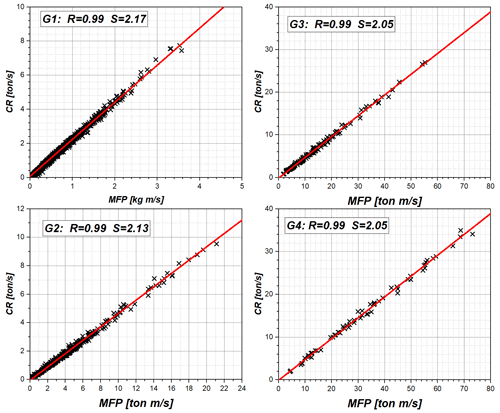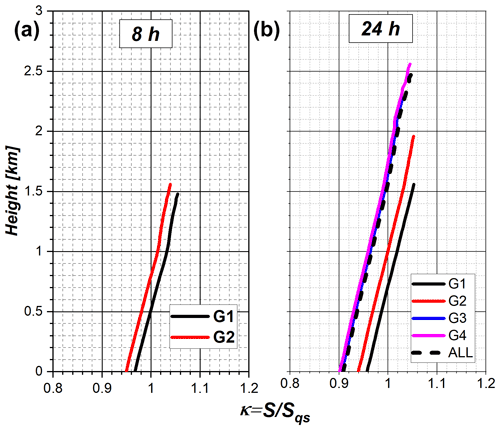Arakawa, A. and Schubert, W. H. : Interaction of a cumulus cloud ensemble
with the large-scale environment. Part I, J. Atmos. Sci., 31, 674–701, 1974.
Cooper, W. A.: Effects of variable droplet growth histories on droplet size
distributions. Part I: Theory, J. Atmos. Sci., 46, 1301–1311, 1989.
Grant, L. D., van den Heever, S. C., Haddad, Z. S., Bukowski, J., Marinescu, P. J., Storer, R. L., Posselt, D. J., and Stephens, G. L.: A Linear Relationship between Vertical Velocity and Condensation Processes in Deep
Convection, J. Atmos. Sci., 79, 449–466, 2022.
Khain, A. P., Ovchinnikov, M., Pinsky, M., Pokrovsky, A., and Krugliak, H.:
Notes on the state-of-the-art numerical modeling of cloud microphysics,
Atmos. Res., 55, 159–224, 2000.
Khairoutdinov, M. F. and Kogan, Y. L.: A Large Eddy Simulation Model with
Explicit Microphysics: Validation Against Aircraft Observations of a Stratocumulus-Topped Boundary Layer, J. Atmos. Sci., 56, 2115–2131, 1999.
Khairoutdinov, M. F. and Randall, D. A.: Cloud resolving modeling of the ARM
summer 1997 IOP: Model formulation, results, uncertainties, and sensitivities, J. Atmos. Sci., 60, 607–625, 2003.
Kogan, Y. L.: A Cumulus Cloud Microphysics Parameterization for
Cloud-Resolving Models, J. Atmos. Sci., 70, 1423–1436, 2013.
Kogan, Y. L.: LES study of precipitation/condensation dependence on cumulus
clouds dynamics, Adv. Sci. Res., 18, 89–92, https://doi.org/10.5194/asr-18-89-2021, 2021.
Kogan, Y. L. and Martin, W. J.: On parameterization of bulk condensation in
numerical cloud models, J. Atmos. Sci., 51, 1728–1739, 1994.
Korolev, A. and Mazin, I. P.: Supersaturation of water vapor in clouds, J.
Atmos. Sci., 60, 2957–2974, 2003.
Paluch, I. R. and Knight, C. A.: Mixing and evolution ofcloud droplet size
spectra in vigorous continental cumulus, J. Atmos. Sci., 41, 1801–1815, 1984.
Pinsky, M., Mazin, I. P., Korolev, A. V., and Khain, A.: Supersaturation and
diffusional droplet growth in liquid clouds, J. Atmos. Sci., 70, 2778–2793,
https://doi.org/10.1175/JAS-D-12-077.1, 2013.
Pinsky, M., Eytan, E., Koren, I., and Khain, A.: Convective and turbulent
motions in non-precipitating Cu. Part II: LES simulated cloud represented by
a starting plume, J. Atmos. Sci., 79, 793–813, https://doi.org/10.1175/JAS-D-21-0137.1, 2022.
Politovich, M. K. and Cooper, W. A.: Variability of the supersaturation in
cumulus clouds, J. Atmos. Sci., 45, 1651–1664, 1988.
Siebert, H. and Shaw, R. A.: Supersaturation Fluctuations during the Early
Stage of Cumulus Formation, J. Atmos. Sci., 74, 975–988, https://doi.org/10.1175/JAS-D-16-0115.1, 2017.
Squires, P: The growth of cloud drops by condensation, Aust. J. Sci. Res., 5,
59–86, 1952.
Suselj, K., Kurowski, M., and Teixeira, J.: A Unified Eddy-Diffusivity/Mass-Flux Approach for Modeling Atmospheric Convection, J.
Atmos. Sci., 76, 2505–2537, 2019.
Tiedtke, M.: A comprehensive mass flux scheme for cumulus parameterization in
large-scale models, Mon. Weather Rev., 117, 1779–1800, 1989.
vanZanten, M. C., Stevens, B., Nuijens, L., Siebesma, A. P. Ackerman, A. S., Burnet, F., Cheng, A., Couvreux, F., Jiang, H., Khairoutdinov, M., Kogan, Y., Lewellen, D. C., Mechem, D., Nakamura, K., Noda, A., Shipway, B. J., Slawinska, J., Wang, S., and Wyszogrodzki, A.: Controls on precipitation and
cloudiness in simulations of trade-wind cumulus as bserved during RICO, J. Adv. Model. Earth Syst., 3, M06001, https://doi.org/10.1029/2011MS000056, 2011.








